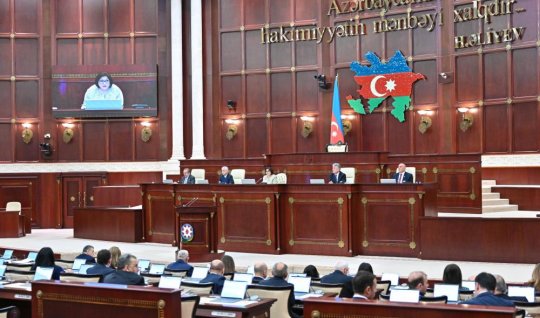In budget execution risks - The Chamber issued a warning

The Azerbaijan Accounts Chamber (AC) warned about a number of risks in its analyses regarding the execution of the state budget for the first half of 2025.
Modern.az reports that this was stated in the Chamber's report.
It was noted that the main share in the annual increase of revenues belongs mostly to oil revenues. Thus, state budget revenues increased by 961.1 million manats in the 6 months of 2025, of which 728.9 million manats or 75.8% was provided by oil revenues (mainly DNF).
Another issue is the failure to consider changes in legal acts during the execution of revenues: "In the 6 months of 2025, the abolished state fee (1.2 million manats) was included in the state budget revenues, and changes to the Law “On State Fees” were not taken into account"
The Chamber also emphasized that low budget discipline continues for some expenditure areas. In January-June of the current year, state budget expenditures were executed at 17.1 billion manats, which constitutes 41.3% of the amount approved for the current year.
The AC also considers it a risk to allocate funds from the free balance of the single treasury account for the reduction of domestic debt, even though it is not stipulated in the legislation: "During the reporting period, 1395.4 million manats were allocated from the free balance of the single treasury account for the reduction of domestic debt. The Law “On the Budget System” does not provide for the allocation of funds from the free balance for the reduction of domestic debt".
On the other hand, the amount intended to be returned to the Guarantee Fund was under-executed. Of the 203.7 million manats of funds paid from the Guarantee Fund intended for return in 2025, 10.7 million manats were returned in the 6 months of the current year, which constituted 5.3% of the total forecast.
The Chamber added that the application of the closed auction mechanism leads to risks in the long-term perspective: "Closed auction operations carried out in the first half of 2025 were of significant importance in managing short-term obligations and ensuring the sustainability of the debt portfolio, and also acted as an effective tool for strengthening financial stability in the market and reducing short-term risks through the issuance of long-term bonds. However, the failure to attract new investors to the market has led to financial flows circulating mainly among state institutions, which, in addition to limiting liquidity opportunities, has reduced the potential for diversification of the debt market, highlighting the importance of a cautious approach in assessing the sustainability of the operation".
-
21:16, Bu günAttention to Azerbaijanis in Russia! - NEW PROHIBITION
-
20:07, Bu günEurope between two fires
-
18:22, Bu gün907th amendment is repealed - Process STARTED
-
17:33, Bu günDiaspora in Kazakhstan awaits the final decision of the aircraft investigation - STATEMENT
-
16:40, Bu gün2 buildings collapsed in Morocco - 22 people died
-
14:58, Bu günThe character of Sara Khatun in a Turkish series - VIDEO
-
14:20, Bu günPutin to visit Turkmenistan tomorrow
-
13:14, Bu günYerevan does not only want to buy fuel from Baku
-
12:56, Bu günAnother section of the border with Armenia will be demarcated
-
12:25, Bu günPashinyan is amending the Constitution: “I am confident that our people will vote”
-
10:32, Bu gün“Upper Lars” road closed: Armenian cars remained at the border
-
10:03, Bu günIran and Russia Discussed the Desiccation of the Caspian Sea
-
08:29, Bu günAmbassador in the US resigned
-
07:50, Bu günPashinyan awaits Turkey's decision
-
00:30, Bu günCalling Russia may be banned
-
9 December 2025, 22:40Trump gave Zelensky a few days' TIME
-
9 December 2025, 21:53Prominent Turkish journalist detained
-
9 December 2025, 21:28I am always ready for elections - ZELENSKY
-
9 December 2025, 20:41Pashinyan signed a declaration with the chancellor
-
9 December 2025, 20:3214 countries to which Azerbaijan sells gas - LIST
-
9 December 2025, 19:25Has the Turkish army entered Syria?
-
9 December 2025, 17:17Higher education will be free in Georgia
-
9 December 2025, 16:52NATO calls me “father” - TRUMP
-
9 December 2025, 16:34Maduro's days are numbered - Trump
-
9 December 2025, 15:56Harsh words from Trump on Ukraine, kind words on Turkey
-
9 December 2025, 15:07When will the aircraft accident investigation be completed?
-
9 December 2025, 15:03Europe's fear of war - Will Russia attack?
-
9 December 2025, 14:22Plane crash in Russia - 7 people died
-
9 December 2025, 12:24The former president wrote about his prison days: “Welcome to hell!”
-
9 December 2025, 12:12New for mopeds rules
























































